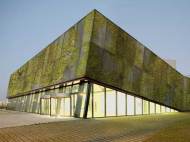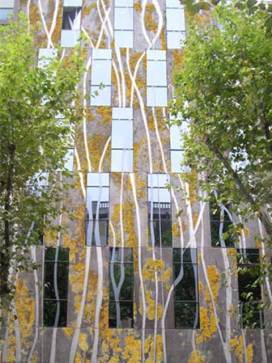Constructing “living” façades with biological concrete
 A group of researchers from the Universitat Politècnica de Catalunya and BarcelonaTech (UPC), Spain, have developed a type of biological concrete that supports the natural, accelerated growth of pigmented organisms. The material has been designed for Mediterranean climates, and it is adapted to offer environmental, thermal and aesthetic advantages over other similar construction solutions.
A group of researchers from the Universitat Politècnica de Catalunya and BarcelonaTech (UPC), Spain, have developed a type of biological concrete that supports the natural, accelerated growth of pigmented organisms. The material has been designed for Mediterranean climates, and it is adapted to offer environmental, thermal and aesthetic advantages over other similar construction solutions.
Unified in the Structural Technology Group, the researchers focused on two types of cement-based materials – carbonated concrete (based on Portland cement) and material manufactured with magnesium phosphate cement (MPC). Carbonated concrete is a material with a pH of around 8, while the material combined with MPC does not require any treatment to reduce its pH, since it is slightly acidic.
Aside being used as a repair material, MPC quick setting properties and low environmental impact made it usable as biocement in the field of medicine and dentistry. This ability inspired the researchers to develop a concrete that could act as a natural biological support for the growth and development of desired biological organisms.
Aside tinkering with the right pH value, the researchers had to pay attention to other properties such as porosity and surface roughness since they influence the ability of the material to act as a host for desired organisms. The researchers propose use of a multilayered panel which consists out of the structural layer, waterproofing layer, biological layer, and the discontinuous coating layer with a reverse waterproofing function.
Waterproofing layer is situated on top of the structural layer, and it is used to protect the latter from potential damage caused by water seeping through. The biological layer is used to support colonization and allow water accumulation within the layer. Aside hosting organisms, it is used to regulate the water retention and expel moisture. The discontinuous coating layer with a reverse waterproofing function permits the entry of rainwater and prevents it from escaping.
The new material, which has various applications, offers environmental, thermal and aesthetic advantages. From an environmental perspective, the biological layer is useful since it absorbs CO2 from the atmosphere. At the same time, it has the capacity to capture solar radiation, making it possible to regulate thermal conductivity inside the buildings depending on the temperature reached. Biological concrete could be used to create natural decorations on buildings.
Aside being used on buildings, biological concrete could be used indoors or in garden areas as decorative elements. UPC researchers are currently collaborating with researchers from the University of Ghent, Belgium, to test the success of biological growth on their concrete.
A patent is in the process of being obtained for this innovative product, and the Catalan company ESCOFET 1886 S.A., a manufacturer of concrete panels for architectural and urban furniture purposes, has already shown their interest for commercialization of biological concrete.










Leave your response!